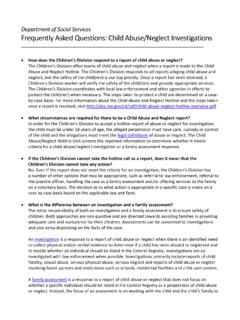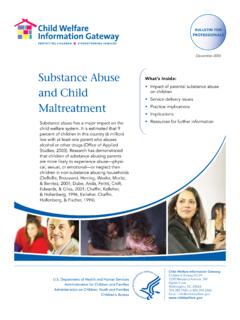Transcription of Law Enforcement Response to Child Abuse
1 Department of JusticeOffice of Justice ProgramsOffice of Juvenile Justice and Delinquency PreventionPortable Guides toInvestigating Child AbuseLawEnforcementResponse toChild AbuseForewordLaw Enforcement Response to Child Abuse like all the PortableGuides in this series is designed to assist those working tohelp protect children from being victimized and to improvethe investigation of Child Abuse guide arms law Enforcement professionals with theinformation needed to ensure consistency in their investigationof Child Abuse . Pertinent considerations and helpfulinvestigatory protocols are provided.
2 Other useful materialsinclude suggestions on working with physicians, responding todomestic disturbance calls, and placing children in protectivecustody. Supplemental readings and additional resources protecting our children from criminal predators, lawenforcement professionals are serving their communities andtheir Nation. We hope that this guide will aid in that Printing May 1997 Second Printing March 2001 NCJ 1624251hild Abuse is a community problem. No singleagency has the training, manpower, resources,or legal mandate to intervene effectively inchild Abuse cases.
3 No one agency has thesole responsibility for dealingwith abused a Child is physicallybeaten or sexuallyabused, the ideal set ofevents is that doctorstreat the injuries,therapists counsel thechild, social servicesworks with the family,police arrest the offender, andattorneys prosecute the case . To promote this Response ,effective community intervention involves the formationof a Child protection team that includes professionalsfrom medicine, criminal justice, social work, andeducation who understand and appreciate the differentroles, responsibilities, strengths, and weaknesses of theother team members but cooperate and coordinatetheir efforts.
4 The skills of each person are viewed asdifferent but equally role of law Enforcement in Child Abuse cases is toinvestigate to determine if a violation of criminal lawoccurred, identify and apprehend the offender, andfile appropriate criminal charges. The Response of lawenforcement to Child Abuse needs to be consistent. Theintent of this guide is to provide officers who respondto this type of crime with information that will ensurethis consistency. It is also to help law enforcementunderstand the importance of developing proceduresand protocols and ways they can work with otherprofessions to ensure that the needs of children are reporting laws requirea referral when there is a suspicion ofabuse.
5 In most Child Abuse cases, lawenforcement becomes involved in oneof two ways: by a referral from a school,a physician, or an agency such as socialservices, or by a direct call for service froma parent, a Child , or a neighbor. Because of increasedreporting of Child Abuse , it is critical that police officersbe trained to handle cases involving Child Abuse cases have unique characteristics that make themdifferent from other types of cases. For a number of reasons,children make perfect victims, and crimes involving childabuse, particularly sexual Abuse , are among the most difficultinvestigated by law Enforcement :YChildren are usually unable to protect themselves because oftheir level of physical and mental development; frequently theydo not like to talk about the Abuse .
6 They may delay disclosureor tell only part of the emotional bond often exists between the Child and theoffender; children may want the Abuse to stop, but they maynot want the offender to be of Abuse are not usually isolated incidents; instead, theytake place over a period of time, often with increasing most sexual Abuse cases, there is no conclusive medicalevidence that sexual Abuse occurred. Moreover, it occurs ina private place with no witnesses to the of children require special handling; legal issuesgoverning Child testimony are complicated and ever changing,and children whether victims or witnesses are often viewedas less credible or competent than the Abuse cases often involve concurrent civil, criminal,and sometimes administrative investigations; they often crossjurisdictional criminal justice system was not designed to handle thespecial needs of must be objective and proactive in their investigationsof Abuse .
7 Questions concerning who, what, where, when, how,and why must be answered. It is important to remember thatchild Abuse is a crime and law Enforcement has a legal dutyand responsibility to respond Team ApproachThe most effective approach to cases involving childmaltreatment is interagency coordination and workers, physicians, therapists, prosecutors, judges,and police officers all have important roles to play. All mustwork together with a common concern the welfare of thechild and with a common goal to communicate with mutualrespect. Differences of opinion are to be expected.
8 Effectiveteamwork includes having a mechanism for discussing and,if possible, resolving these members of the Child protection team have an obligationto appreciate what the other professionals on the team areseeking to accomplish and to understand how their activitiesinterrelate. For example, law Enforcement officers need to beconcerned that their investigation might traumatize a Child ,and physicians and therapists need to be concerned that theirtreatment and evaluation techniques might hinder or damagelaw Enforcement s investigation. An ongoing discussion ofproblems that the team encounters during investigations willhelp resolve them and will also clarify the roles andresponsibilities of team players on the Child protection team must have clearlydefined roles in order to carry out their interagency protocol helps in establishing written guidelinesfor those who investigate cases of Child Abuse and properly drafted agreement also provides a blueprint foreach of the principal agencies responsible for Abuse cases inthe team members must also invest their time in
9 Developinga long-range strategic plan that will ensure the team is everresponsive to the needs and changes within the goal should be efficient coordination of services, withthe chief objectives being to determine what happened andto meet the needs of the following are essential elements of an effectiveinterdisciplinary Response team:YIdentification of the scope of the community of the resources of communication guidelines for each responseteam member and the victim s of clearly defined roles and responsibilities foreach Response team of clearly defined criteria for the types of caseswith which the team will become Law EnforcementProtocols and ProceduresWith their legal authority to investigate violations of the law,law Enforcement officers are vital members of a community schild protection team.
10 Failure to respond properly to childabuse cases from the outset ( , failure of the responding lawenforcement officer to obtain certain information) can result incases being dismissed in court or, in some cases, in innocentpeople being falsely should be trained and experienced in objectivelyinvestigating Child maltreatment, including conducting interviewsof children and interrogating suspected offenders. Trainingshould be viewed as an ongoing process, designed to increasethe competence of the interdisciplinary , local law Enforcement departments must establishpolicies and procedures to investigate Child Abuse investigating Child Abuse need to consider manyimportant factors (see figure 1, Considerations for ChildAbuse Investigations, pages 6 and 7).















